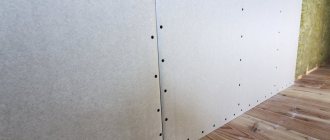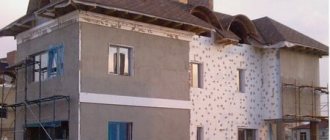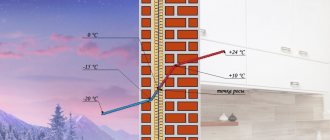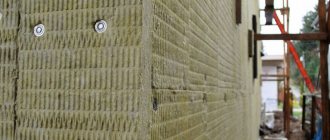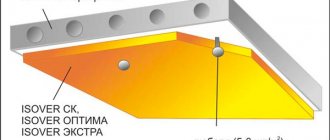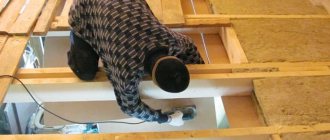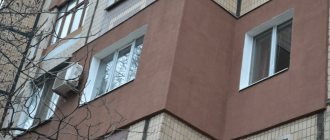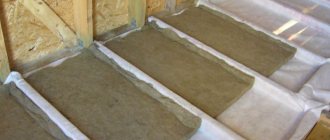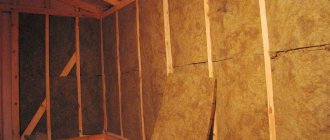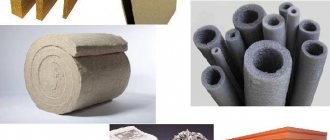What is the best way to insulate: outside or inside?
According to all construction canons, the best option is insulation from the outside. The thing is that the boundary between the thermal insulation material and the sheathing is the zone where condensation forms. And if you do insulation from the inside, then this zone falls between the insulation and the walls of the garage. At the same time, the latter freeze completely (through and through) in winter, which negatively affects the building material itself. Plus, condensation, which reduces the performance characteristics of any building material.
This is the first reason. The second is the ability not to reduce useful space in the garage. Insulation installed on walls takes up some space. Here you will have to add the thickness of the skin. That is, on each side of the walls there will be a reduction of approximately 3-5 cm.
The third reason makes it possible not to pay attention to the environmental friendliness of the thermal insulation material. It will be located on the outside, street side, which means that if the insulation releases substances harmful to humans, they will immediately evaporate. Moreover, such materials are much cheaper than environmentally friendly ones.
Insulation of the garage from the outside Source remstroiblog.ru
But it is not always possible to insulate the garage walls from the outside. If for some reason this cannot be done, then all thermal insulation work is moved inside.
No. 2. Liquid polyurethane foam
Insulation with sprayed polyurethane foam is one of the most modern methods , which has almost no disadvantages. In this case, the garage owner receives a monolithic layer of thermal insulation that fills all the cracks and uneven surfaces. This material has phenomenal thermal insulation properties, since its thickness of 1 cm can replace polystyrene foam 15 cm thick. It also has excellent sound insulation, because its cellular structure almost does not conduct sound. Polyurethane foam is not exposed to fire, after drying it does not emit substances harmful to health, and the process of applying it does not take much time. In addition, this option is also excellent in cases where the garage has a complex structure or some hard-to-reach places where it is difficult to mount a roll of cotton wool or a foam board, but a sprayer with liquid polyurethane foam will always fit through. The material perfectly withstands critically low and high temperatures without deforming; it has good adhesion to almost all surfaces, so it can be used with equal success for brick and metal garages. Plus, it's lightweight and durable, making it the most attractive insulation material available right now.
But, unfortunately, it was not without its drawbacks .
This material is not very cheap, and the work of applying it will require the involvement of professionals with special equipment. Another drawback is the fear of sunlight, so when insulating the garage externally, the dried layer of insulation must be additionally protected. It can be panels, plaster or the most ordinary paint: as a result, the garage and insulation will be protected and have an attractive appearance.
Overview of the thermal insulation materials market
Before moving on to the process of insulating a garage structure, let’s talk about insulation materials. About those that are used today for this purpose. There is a fairly large layer of building materials of this type that builders use today. There are traditional materials here, and others that have appeared recently, but have already gained popularity.
Mineral wool
This insulation has been used in construction for a long time. At the very beginning of its appearance, it was a roll-type material. Today it is still produced in this design, but the modern form of mineral wool is slabs. They are called mineral wool slabs.
It should be noted that a fairly wide range of materials is used as raw material in mineral wool slabs. But basalt-based insulation is very popular. This thermal insulation material is presented on the market in slabs of different densities and thicknesses. This makes it easier to select according to the required characteristics.
Mineral wool boards are a popular insulation material Source 2gis.kz
The only drawback of mineral wool is its hygroscopicity. That is, this material absorbs moisture well, while losing its thermal characteristics. To prevent this from happening, the heat-insulating layer is covered with waterproofing films on both sides. Today, manufacturers offer moisture-resistant mineral wool slabs, in which hygroscopicity is reduced to the maximum. This makes it possible to refuse waterproofing.
Will not talk about all the technical characteristics of mineral wool. Let us designate the most significant one, according to which you need to choose insulation. This is the thermal conductivity of the material.
On a note! Thermal conductivity is the property of a material or body to transfer heat. The lower this parameter, the better in terms of insulation.
So for mineral wool this characteristic is 0.035-0.04 W/m K.
Expanded polystyrene boards
Many people call this material foam plastic, which is fundamentally wrong, although both materials are included in the group of foamed plastics made from polystyrene. It’s just polystyrene foam – a material originally created for packaging. It has low density and low thermal insulation qualities. The same cannot be said about expanded polystyrene, which was originally developed as a thermal insulation material.
Moisture-resistant polystyrene foam boards Source www.stroyportal.ru
See also: Catalog of popular plots in the Moscow region for the construction of a country house
This foam insulation has serious advantages:
- thermal conductivity – 0.028-0.034 W/m K;
- the extruded version does not absorb moisture ;
- passes air through itself;
- strength – 1 kg/cm²;
- inert to many chemicals;
- mold and fungi do not live on the surface of the insulation
- it is a good sound insulator ;
- service life – 30 years.
But polystyrene foam boards also have their drawbacks. And the most important of them is fire hazard. The insulation burns well and maintains combustion, while emitting acrid smoke. Today, manufacturers are trying to change the situation with this indicator. Fire-resistant boards have already appeared on the market, but there are not many of them.
And one more point that you need to pay attention to when choosing expanded polystyrene as insulation. This is the brand of material. The optimal option for a garage is PSB-S-35 (40) - self-extinguishing, with a density of 40 kg/m³. The thickness of the slabs should not be less than 50 mm.
Expanded polystyrene boards brand PSB-S-35 Source karkasdomproekt.ru
Polyurethane foam
This is a two-component material, the ingredients of which are mixed before application. In terms of its physical state, it is a foamed semi-liquid mass that hardens in air, forming a hydrophobic layer on the insulated surface. That is, not afraid of moisture.
Application of polyurethane foam requires special equipment. It is applied under pressure from a hose with a nozzle. The high adhesive characteristics of the material give it the ability to adhere to any surfaces that are previously cleaned of dirt and rust. In this case, the mixture fills all the cracks, gaps and holes.
This is a non-flammable insulation. Service life – 50 years. Thermal conductivity – 0.019-0.028 W/m K. moisture absorption is minimal – 1.2%.
Layer of applied polyurethane foam Source foamshop.ru
See also: Catalog of companies that specialize in the construction of small architectural forms
Warm plaster
This plaster solution got its name because manufacturers add particles of heat-insulating material to its composition. These can be polystyrene foam granules, so-called crumbs, vermiculite (foamed rock of volcanic origin), sawdust and other ingredients.
In fact, such a plaster mixture has higher thermal insulation characteristics than conventional plaster. But to achieve a good effect, the material must be applied in a sufficiently thick layer. It is used both for insulating the garage from the inside and for thermal insulation from the outside. It is understandable if the garage is built from bricks, blocks or concrete slabs. For a metal structure this option is unacceptable.
Warm plaster is applied to the wall in a thick layer Source tk101.ru
So, we have looked at the main thermal insulation materials that are most often used today when insulating a garage building. Of course, this is not the entire list of proposed options. They just use these more often.
Most often, many consumers are looking for how to insulate a garage from the inside inexpensively. The table provides a comparison of prices for the described insulation materials.
| Insulation | Mineral wool boards | Expanded polystyrene boards | Polyurethane foam | Warm plaster |
| Price | 13-20 rub. for 1 m² | 15-50 rub. for 1 m² | 1200-1500 rub. for 1 m² | 350-750 rub. for 1 m² |
The price range for each material is quite wide. This is explained by the fact that the basis for pricing is the thickness of the insulation and its density. The table shows that the most inexpensive option is mineral wool and polystyrene foam boards.
The most economical thermal insulation materials Source krysha-expert.ru
No. 4. Glass wool
Glass wool, as mentioned above, is a type of stone wool, but still it is better to dwell on this type of insulation separately. Its main advantage is the price, because it costs an order of magnitude cheaper than stone wool, and this material is easy to transport, because it is vibration-resistant, and after delivery it will return to its original form, even if it was tightly rolled into a roll. In some properties, this insulation is not inferior to stone wool, having good thermal insulation performance, and many experts in terms of insulation efficiency do not see the difference between these materials, which is why they choose a cheaper option.
When trying to save money, you need to be aware that you need to work with such material extremely carefully. Yes, installing glass wool is almost no different from the process of insulating a garage with stone wool, because you will also need to build a frame. But at the same time you will have to work extremely carefully, covering your body, eyes, face, hands and any other open areas. The structure of glass wool is such that it contains many small needle-like particles that easily penetrate the skin, respiratory tract and eyes. If you follow all safety precautions, then, in principle, glass wool can be called a good competitor to basalt wool. Naturally, a layer of such thermal insulation must be reliably covered with other materials that will protect the cotton wool itself from moisture, and a person from the negative influence of cotton wool.
Insulation technologies
Having dealt with the question of how to insulate a garage, we move directly to the process itself. Let's start with external insulation. The simplest option is plastering. Everything is quite simple here. Warm plaster is applied to the external surfaces of the garage walls using standard technology. That is, they throw it onto the surface with a trowel and level it with the rule according to the installed beacons.
There is an option for mechanized plaster. To do this, special stations are used in which the plaster mixture is prepared and then immediately applied to the walls under pressure. In this way, insulation can also be carried out from the inside of the room.
How to insulate a brick garage
Proper insulation of a brick garage
Very often, car owners believe that the temperature inside the garage should be almost the same as in the house. But this is an erroneous opinion, since when driving from the cold into a warm garage room, the car will definitely become covered with condensation. Which in turn will destroy its anti-corrosion coating, which will lead to the appearance of rust and subsequent destruction of the metal parts of the car.
During construction, the garage walls are not laid out thick enough. Naturally, they cannot prevent cold air from entering the room in winter. For this purpose, the walls of the building are insulated. Let's take a closer look at how to insulate a brick garage.
Important: the temperature inside the garage should be no more than 5-6 degrees so that the difference between the temperature inside and outside is minimal.
Video description
In order not to go into details of the technological process, we suggest watching a video that explains how to properly apply warm plaster to walls in two ways:
Expanded polystyrene boards for external insulation
If the garage is built from bricks or blocks, then polystyrene foam boards can simply be attached to the wall surfaces, laying them tightly together. There are two mounting methods:
- on mushroom-shaped screws or, more precisely, on dowel-nails for insulating materials;
- on the adhesive composition.
Usually the first one is used, because glue for polystyrene foam is an expensive thing. It is sold in cans. The contents are applied to the back of the slab in the corners and in the middle. And then they just press him to the wall.
As for self-tapping screws, these are special plastic fasteners consisting of two parts: a dowel and a nail. Under the first one, a hole is made through the insulation in the wall into which the dowel is inserted. At the same time, its wide cap will hold the insulating board. After which the second part is hammered into it, which bursts open the first.
Dowel nail for insulation boards Source de.decorexpro.com
Typically, two fasteners are used for each slab. When laying thermal insulation, it is very important to ensure that there are no gaps or cracks between its elements. It is optimal to use slabs with a tongue-and-groove connection for this purpose. If ordinary slabs with smooth edges are used, then when gaps form between them, the latter are filled with special foam. It is similar to the assembly one, only it does not expand in volume when exposed to air.
How polystyrene foam boards are attached to the wall with mushroom-shaped nails Source stroyfora.ru
Insulation options for garages built from different materials
To choose one or another technology for insulating a garage, you will have to weigh many pros and cons, “try on” various insulating materials to suit the features of the building and your own wallet. A thermal engineering calculation will also be required, taking into account the climate in the region, the thickness and material of the enclosing structures. For example, walls made of aerated concrete blocks with a large number of air pores themselves have good resistance to heat loss. At the same time, metal frame buildings seriously lose in this regard.
There are three options for insulating a garage:
- external;
- internal;
- combined is the most effective and expensive.
Insulation along the facade is vital for buildings that tend to accumulate moisture: wooden frames and garages made of porous concrete blocks . In a good way, metal boxes also need to be insulated from the outside, since their dew point is always on the inner surface. But it is difficult to do such work on your own, so we will consider this option as an exception to the rule.
It would be correct to insulate the garage from the outside - this is the only way to move the dew point outside the enclosing structures and protect them from getting wet when condensation forms
It is also advisable to protect brick and concrete buildings from the outside, but installing thermal insulation from the inside is cheaper - the choice remains with the owner. Here we will have to additionally take into account the safety of the materials used for the human body. Of course, none of them are absolutely harmless - even natural wood is treated with chemical impregnations - but you need to strive for this. The safest products are considered to be from well-known brands that monitor the maximum permissible concentrations of phenols, formaldehydes and styrene in their materials.
If you use an unheated garage in the winter, you still need interior insulation. Otherwise, you get a simple carport with a gate that protects the car from precipitation, but not from cold. But you can refuse external insulation.
Separately, it is worth considering the insulation of the garage roof, since a lot of heat is lost through it . It all depends on the design and availability of the attic space. Possible options for roofing of different configurations:
- Flat or with a slight slope allows insulation to be laid on top. It is better to use rigid slabs of polystyrene foam or extruded polystyrene foam (EPS), and waterproof the top using roll materials.
- The pitched roof is insulated with the same polystyrene foam or mineral wool laid between the rafters. The latter option is preferable because it does not require particularly precise sizing and additional fasteners.
- In a garage with a cold attic, you can line the floor with glass wool rolls - you will get reliable and budget-friendly thermal insulation. The main thing is that the roofing material protects it well from getting wet, and ventilation ensures removal of accumulated moisture.
We also allow the option of insulating the ceiling in the garage. The same materials are used here as for wall insulation: mineral wool, rigid polymer boards. This solution allows you to create a continuous “warm” contour without gaps or cold bridges. But it is necessary that on the side of the room it is covered with a vapor barrier that cuts off moist air. Additional waterproofing on top is required.
Insulation of the floor and ceiling in the garage
The floor is easiest. This is a thick concrete screed, under which you just need to lay insulation. Expanded clay is most often used for this. They do it like this:
- At the site where the garage is installed, a pit is dug up to 50 cm deep.
- Crushed stone is poured into it in a layer of 15 cm.
- Then sand in a layer of 15 cm with compaction.
- Cover with roofing felt in two perpendicular layers.
- Expanded clay is poured.
- Another waterproofing layer .
- A reinforcing grid of steel reinforcement is laid.
- Pouring concrete.
You don’t have to fill in expanded clay, but use expanded clay concrete mortar instead of concrete. Instead of expanded clay, you can fill in perlite or lay polystyrene foam boards.
Layers of insulated garage floor Source mirstrojka.ru
As for the insulation of the ceiling, everything will depend on what this building element of the garage structure is.
- If it is a concrete floor slab , then it is better to assemble a suspended structure into which insulation is placed. You can use warm plaster.
- If it is a metal roof , then it is optimal to treat it with polyurethane foam.
- Since the roof of a metal garage is assembled, like the walls, in the form of a frame sheathed on the outside with iron, slab insulation . The technology is the same as on the walls.
Gate insulation finishing
Insulating garage doors
When insulating a garage, you should pay special attention to the gates, since a lot of heat is lost through them. Is it possible to eliminate unnecessary heat loss and insulate garage doors ? To do this, it is better to make a door in one of the gate leaves.
The gate leaf is usually insulated with polystyrene foam. A sheathing is mounted on the inside, then sheets of expanded polystyrene (foam) are attached to it. The gaps where the gates close are treated with special adhesive tape. You can install seals in places where air penetrates. Next, waterproofing is performed. For the final cladding of the gate, you need to mount the frame. Experts recommend using OSB or thin boards as finishing materials.
Important: the gate panels are usually metal, so before insulation they need to be thoroughly treated with anti-corrosion mixtures. You can use regular drying oil for this, just warm it up a little.
Insulating walls with foam plastic from the outside: instructions and photo gallery
Traditionally, before starting work, we prepare surfaces for insulation: we remove peeling pieces, repair chips and potholes, and clean the walls of dirt. Brickwork or concrete with their absorbent properties must be additionally treated with a penetrating primer. After this, insulation is performed in the following order:
- Attach a metal corner to the bottom of the walls - it will serve as a support for the rows of foam plastic.
- Prepare the adhesive mixture according to the instructions given on the package.
- Apply the composition to each sheet using one of the methods shown in the photo.
This method is only suitable for polymer adhesives in cylinders. The glue is applied with a notched spatula in a layer of 3–4 mm. The “blots” of glue should be evenly distributed on the sheet. - One after another, sheets of foam plastic are glued along the lower edge with emphasis on the metal profile. Work is carried out starting from the corner.
- All subsequent rows of polystyrene foam are attached with the seams staggered.
- The joints between the sheets are sealed with polyurethane foam.
Don’t forget to check the verticality of the foam “wall” with a level - this will make further finishing easier - After about a day or two, when the glue has set, the foam can be additionally secured with dowel mushrooms. They are screwed into the corners of each sheet and in the center.
- Reinforcing the foam is a mandatory step, at which the insulation is covered with another layer of glue.
While the reinforcing composition has not dried, a fiberglass mesh is embedded in it. After the top layer has set, they proceed to finishing.

